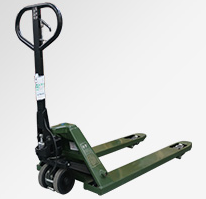News Details
The working process of the hydraulic system of a manual hydraulic transport vehicle
Manual hydraulic handling vehicle is a commonly used tool for cargo handling, which relies on hydraulic oil to lift the forks during operation, thereby lifting the cargo off the ground for handling. How does the hydraulic system of a manual hydraulic transport vehicle operate.
The working process of the hydraulic system is as follows: hydraulic oil is pressurized by a vane pump, passes through an oil filter, explosion-proof electromagnetic directional valve, throttle valve, hydraulic control check valve, and balance valve to enter the lower end of the hydraulic cylinder, causing the piston of the hydraulic cylinder to move upward, thereby lifting heavy objects. The return oil at the upper end of the hydraulic cylinder will pass through an explosion-proof electromagnetic directional valve and return to the oil tank. Its rated pressure can be adjusted through an overflow valve, and the reading on the pressure gauge can be observed.

When the piston of the hydraulic cylinder moves downwards (i.e. the weight drops), the hydraulic oil will enter the upper end of the hydraulic cylinder through the explosion-proof electromagnetic directional valve, and the return oil at the lower end of the hydraulic cylinder will return to the oil tank through the balance valve, hydraulic control check valve, throttle valve, and explosion-proof electromagnetic directional valve.
In order to ensure smooth descent of heavy objects and safe and reliable braking, we have installed a balance valve on the return oil circuit to maintain pressure balance, so that the descent speed is not affected by changes in heavy objects. By adjusting the flow rate through a throttle valve, the lifting speed can be controlled. To prevent unexpected situations, we have also added hydraulic control check valves (i.e. hydraulic locks) to ensure safe self-locking in the event of an unexpected hydraulic pipeline rupture.

